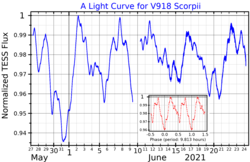HD 149404
 A light curve for V918 Scorpii, plotted from TESS data.[1] The inset plot shows the same data folded with the orbital period, and averaged into 100 bins per orbit. | |
| Observation data Epoch J2000.0 Equinox J2000.0 | |
|---|---|
| Constellation | Scorpius |
| Right ascension | 16h 36m 22.56285s[2] |
| Declination | −42° 51′ 31.9021″[2] |
| Apparent magnitude (V) | 5.42 - 5.50[3] |
| Characteristics | |
| Spectral type | O7.5I(f) + ON9.7I[4] |
| U−B color index | −0.55[5] |
| B−V color index | +0.40[5] |
| Variable type | ELL[3] |
| Astrometry | |
| Proper motion (μ) | RA: −3.375±0.081[2] mas/yr Dec.: −3.306±0.069[2] mas/yr |
| Parallax (π) | 0.7601 ± 0.0709 mas[2] |
| Distance | 4,300 ± 400 ly (1,300 ± 100 pc) |
| Orbit[4] | |
| Period (P) | 9.81475 d |
| Eccentricity (e) | 0.0 (assumed) |
| Periastron epoch (T) | 2451680.279±0.174 |
| Semi-amplitude (K1) (primary) | 59.7±2.0 km/s |
| Semi-amplitude (K2) (secondary) | 98.7±3.2 km/s |
| Details | |
| Primary | |
| Mass | 50.5±20.1[6] M☉ |
| Radius | 19.3±2.2[6] R☉ |
| Luminosity | 430000+52000 −46000[6] L☉ |
| Surface gravity (log g) | 3.55±0.15}[6] cgs |
| Temperature | 34000±0.15[6] K |
| Secondary | |
| Mass | 31.9±9.5[6] M☉ |
| Radius | 25.9±3.4[6] R☉ |
| Luminosity | 380000+37000 −34000[6] L☉ |
| Surface gravity (log g) | 3.05±0.15[6] cgs |
| Temperature | 28000±0.15[6] K |
| Other designations | |
| Database references | |
| SIMBAD | data |
HD 149404, also known as HR 6164 and V918 Scorpii, is a star about 4,300 light years from the Earth, in the constellation Scorpius.[2] It is a 5th magnitude star, so it will be faintly visible to the naked eye of an observer far from city lights.[2] It is a rotating ellipsoidal variable, a binary star for which the two stars' combined brightness varies slightly, from magnitude 5.42 to 5.50, during their 9.8 day orbital period.[3] It is one of the brightest members of the Ara OB1 association, which has the open cluster NGC 6193 at its center.[8]
The brightness variability of HD 149404 was marginally detected by the Argentinian astronomer Alenjandro Feinstein, during a photoelectric photometry study undertaken from 1963 through 1965.[9] It was given the variable star designation V918 Scorpii in 1980.[10] In 1977, Peter Conti et al. discovered that HD 149404 has double spectral lines, implying it is a spectroscopic binary.[11] Philip Massey and Peter Conti derived the first set of orbital elements for the binary system, in 1979.[12]
The secondary star in the HD 149404 system is believed to have originally been the more massive of the two, but it is now less massive than the primary due to mass transfer caused by Roche lobe overflow in the past.[6] The secondary may still be close to filling its Roche lobe.[4] It is a rare ON supergiant, a star with unusually strong absorption lines of nitrogen in its stellar spectrum.[13] Spectroscopic studies show that both stars have a stellar wind and a shock is formed where the two winds collide, which produces emission line features.[4]
References
- ^ "MAST: Barbara A. Mikulski Archive for Space Telescopes". Space Telescope Science Institute. Retrieved 19 February 2023.
- ^ a b c d e f g Vallenari, A.; et al. (Gaia collaboration) (2023). "Gaia Data Release 3. Summary of the content and survey properties". Astronomy and Astrophysics. 674: A1. arXiv:2208.00211. Bibcode:2023A&A...674A...1G. doi:10.1051/0004-6361/202243940. S2CID 244398875. Gaia DR3 record for this source at VizieR.
- ^ a b c N. N. Samus; O. V. Durlevich; et al. "V918 Sco database entry". Combined General Catalog of Variable Stars (2017 ed.). CDS. Retrieved 2023-02-19.
- ^ a b c d Rauw, G.; Nazé, Y.; Carrier, F.; Burki, G.; Gosset, E.; Vreux, J. M. (March 2001). "The strange case of the massive binary HD 149404". Astronomy and Astrophysics. 368: 212–224. Bibcode:2001A&A...368..212R. doi:10.1051/0004-6361:20000527.
- ^ a b Humphreys, R. M. (January 1975). "Spectroscopic and photometric observations of luminous stars in the Centaurus-Norma (l = 305 - 340 ) section of the Milky Way". Astronomy and Astrophysics Suppl. Ser. 19: 243–247. Bibcode:1975A&AS...19..243H.
- ^ a b c d e f g h i j k Raucq, F.; Rauw, G.; Gosset, E.; Nazé, Y.; Mahy, L.; Hervé, A.; Martins, F. (April 2016). "Observational signatures of past mass-exchange episodes in massive binaries: The case of HD 149 404". Astronomy and Astrophysics. 588: A10. arXiv:1601.08083. Bibcode:2016A&A...588A..10R. doi:10.1051/0004-6361/201527543.
- ^ "HD 149404 -- Blue Supergiant". SIMBAD. Centre de données astronomiques de Strasbourg. Retrieved 2023-02-18.
- ^ Thaller, M. L.; Gies, D. R.; Fullerton, A. W.; Kaper, L.; Wiemker, R. (June 2001). "A Spectroscopic Search for Colliding Stellar Winds in O-Type Close Binary Systems. V. HD 149404". The Astrophysical Journal. 554 (2): 1070–1078. Bibcode:2001ApJ...554.1070T. doi:10.1086/321409.
- ^ Feinstein, A. (1968). "A Survey of Southern Be Stars. II. Photometric data". Zeitschrift für Astrophysik. 68: 29–47. Bibcode:1968ZA.....68...29F.
- ^ Kholopov, P. N.; Samus, N. N.; Kukarkina, N. P.; Medvedeva, G. I.; Perova, N. B. (February 1981). "65th Name-List of Variable Stars" (PDF). Information Bulletin on Variable Stars. 1921: 1. Bibcode:1981IBVS.1921....1K. Retrieved 21 February 2023.
- ^ Conti, P. S.; Leep, E. M.; Lorre, J. J. (June 1977). "Spectroscopic studies of O-type stars. VIII. Radial velocities and the K-term". Astrophysical Journal. 214: 759–772. Bibcode:1977ApJ...214..759C. doi:10.1086/155305.
- ^ Massey, P.; Conti, P. S. (1979). "The O-type spectroscopic binary system HD 149404". IAU Symposium. 83: 271–275. Bibcode:1979IAUS...83..271M.
- ^ Walborn, N. R.; Panek, R. J. (1985). "Ultraviolet spectral morphology of the O stars. III. The ON and OC stars". The Astrophysical Journal. 291: 806. Bibcode:1985ApJ...291..806W. doi:10.1086/163116.
